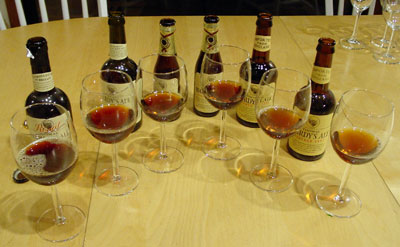
Six vintages of the classic Thomas Hardy’s Ale. Five courtesy of Real Beer co-founder Mark Silva and one from advertising sales director Banjo Bandolas.
On occasion those of us at Real Beer feel compelled to join you in the beer fun. In this case hosted by Pat Hagerman, who launched Real Beer with Silva back when most of us were still trying to figure out how to download a web browser.
The night before we had sampled vintages of Samichlaus (detailed here), so we knew better than to expect too much from the 1983 bottle that Banjo brought (not his fault). Like the Samichlaus, the cap had rust on the inside. Because the bottle had traveled on its side (you can bet TSA opened that bag) it had a strange and scary-looking coating that wrapped around about one-third of the inside.
We’ll get right to it. It tasted liked corked port with lemon. When we were done we each had five empty glasses and one we’d barely touched. Silva tried to salvage his, pouring it through a coffee filter (to remove the apparent sludge). He insisted that made it better, and perhaps we would have agreed – had the other vintages not been so good.
I was a little surprised to find a certain consistency across the beers. Nearly 10 years ago Randy Mosher tasted eight vintages (1986-1995, but not all years) to contribute to a story for All About Beer magazine.
Instead of a neatly vertical progression, I discovered a deliciously erratic jumble of beers, each with its own distinct mix of personality traits. All of them were enormous blasts of malty complexity, a candy shop full of dried fruit, nuts and caramel, but the balance, sweetness, oxidized character, carbonation and color were all over the place.
I suspect that’s because the beers he tasted were provided by the brewery. We visited what was then the Eldridge Pope brewery in 1994 and saw that they stuck older bottles of Hardy’s just about anywhere. They didn’t get as warm or cold as they might have in a Los Angeles garage (where our 1983 was stored) but they weren’t treated like they might be by an anal-retentive beer geek – not to say that describes Silva (that would be more like me).
After we’d sampled all of them, Pat said of the 1997, “This would be great if you didn’t have the others.”
Certainly the beers varied, but generally were better the older they were and the 1989 was clearly the star.
The 1996 flashed more whisky malt character, the 1995 had a layer of vegetal on top of caramel and toffee that you just know is going to go away sooner than later. You couldn’t ask much more of the 1994, with an almost fresh breadiness (cinnamon rolls?), as well a caramel and licorice, with pleasing Madeira just beginning to emerge.
And then there was the 1989. Full of dark fruit, raisins and plums, nutty, a chocolate smokiness, all the things we like about sherry, frankly too many flavors to note and still enjoy the beer. So I quit taking notes.
If you open a 1989 Hardy’s will it taste the same? No guarantees. Every time you choose to cellar a beer (and particularly to let one get to be 18 years old) you are taking a chance.
Sometimes it’s worth it.

i had the lucky chance to partake of an 89 just back in december. deleriously good!
and the guy that shared it has a whole case 🙂
I thought you might like to read the following about a three way tasting I conducted in January.
Kind regards,
Geoff Griggs
(New Zealand beer writer)
Beer worth waiting for
Last week our final visitors of the holidays came bearing gifts of a particularly welcome nature. Knowing how much I’d appreciate the opportunity to taste them our friends Paul and Jacky, who’ve recently shifted to Christchurch from Wellington, had raided their beer cellar and brought me three bottles of one of Britain’s strongest and most revered vintage beers, Thomas Hardy’s Ale.
Named after the famous English author, the beer weighs in at over 11 percent and was first brewed by the Eldridge Pope brewery in the Dorset town of Dorchester in November 1967. After eight months of secondary fermentation and maturation the first batch was bottled in July 1968. The beer was launched later that year at a literary festival to mark the fortieth anniversary of Hardy’s death.
Apparently Alfred Pope, the first Chairman of Eldridge Pope Brewery, was a close friend of Thomas Hardy. It is believed that Hardy enjoyed a strong beer produced by the brewery and subsequently wrote about it in his book “The Trumpet Majorâ€. “It was of the most beautiful colour that the eye of an artist in beer could desire; full in body, yet brisk as a volcano; piquant, yet without a twang; luminous as an autumn sunset; free from streakiness of taste; but, finally rather heady”, wrote Hardy. His words could well have been written for Thomas Hardy’s Ale.
Eldridge Pope brewed the beer for the last time in 1999 – the brewery was sold and closed shortly afterwards – and many beer aficionados thought they had seen the last of this classic English ale. However with continuing strong demand, particularly from the US, the recipe and license to brew Thomas Hardy’s Ale was bought by the respected English craft brewer, O’Hanlon’s.
The oldest of our three bottles was dated 1st January 1979 and its rear label proudly claimed; “This beer will improve if kept at 55°F (12°C) and will last at least 25 years.†This was just as well considering it was now entering its 28th year! The second bottle was just two years younger and the third, a comparative babe-in-arms, was from 2003. Each was carefully opened and the precious liquid decanted gently off the yeast into a jug before being poured into XL5 tasting glasses.
As expected the 2003 vintage, the first brewed by O’Hanlon’s, was still in its infancy. We immediately noticed it was a shade paler than the rich chestnut hue of the two older beers. As it warmed in the glass the aroma was fragrant but sweet, with fruity (apple and banana) esters combining with toffee and orange from the malt and hops. In the mouth it was equally sweet, its chewy maltiness eventually tempered by a late, resiny hop bitterness.
The two elderly examples were altogether different. Despite both showing the sherry-like oxidative notes you’d expect of beers (or wines) of this age, the two beers were quite dissimilar. Our initial impressions of the 1981 bottle were unfavourable; we first detected unpleasant metallic and mushroomy aromas, but fortunately these soon blew off leaving notes of figs and roses, before a lingering savoury finish. Remarkably, after a quarter of a century, the beer still offered a full, rich, almost oily mouthfeel.
Two years older, the 1979 brew had become lighter in body and had developed a late, Islay whisky-like smokiness, along with notes of molasses and liquorice. Still very complex and interesting, the beer was perhaps a shade beyond its best. Paul had shipped this particular bottle with his household belongings when he migrated to New Zealand a few years ago and I suspect the transportation hadn’t done the beer any favours.
Having tasted all three vintages we rated the 1981 brew, at 25 years old, our favourite, with the older brew close behind. The serious sampling work done, we then enjoyed what was left of the beers with a wedge of Whitestone Highland Blue cheese. Fantastic!
At around $9 for a 250 ml. bottle Thomas Hardy’s Ale is one of the most expensive beers on sale in New Zealand, but it’s a genuine world classic and any investment will be well rewarded. Just remember, you have to be very very patient.
Cheers!
I opened a 1981 bottle at 5 am just after the birth of my first child in 1992. Is there a better way to celebrate?
In reference to Kevin Bowman’s question – opening a bottle of 1992 when he turns eighteen and leaves the next will be a close second.
I have a bottle of 1989 Samichlaus (Dark) that has been in my cellar since probably 1990-ish…
This week I collected my 1st Social Security Check! Here’s how I’ll celebrate…1 bottle of ’86, 1 bottle of ’87, 1 bottle of ’89 & 1 bottle of ’91. I’ll have some help (of course!). When I look back over the years I started out with 4 bottles of each “vintage” & some (an ’84 & 85) that never made it as long in the cellar before they went the way of all great beers. Life is good!!